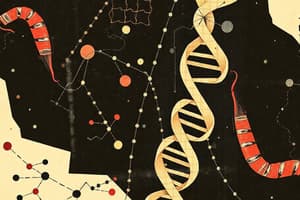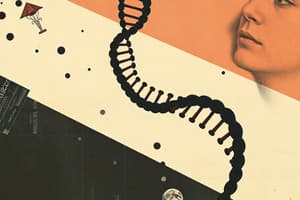Podcast
Questions and Answers
What is the correct direction for nucleic acid synthesis?
What is the correct direction for nucleic acid synthesis?
- 5' to 5'
- 3' to 3'
- 3' to 5'
- 5' to 3' (correct)
Which type of DNA is found in both plants and bacteria?
Which type of DNA is found in both plants and bacteria?
- Plasmid DNA (correct)
- Chloroplast DNA
- Mitochondrial DNA
- Genomic DNA
What is the role of primers in DNA replication?
What is the role of primers in DNA replication?
- To provide orientation for DNA polymerase (correct)
- To visualize DNA in gel electrophoresis
- To cut DNA at specific sequences
- To denature proteins during isolation
Which enzyme is responsible for adding nucleotides in the 5' to 3' direction and synthesizing DNA?
Which enzyme is responsible for adding nucleotides in the 5' to 3' direction and synthesizing DNA?
Which of the following substances is used for visualizing DNA in gel electrophoresis?
Which of the following substances is used for visualizing DNA in gel electrophoresis?
What is the primary function of CRISPR-Cas9 in modern applications?
What is the primary function of CRISPR-Cas9 in modern applications?
Which of the following best describes cDNA libraries?
Which of the following best describes cDNA libraries?
Which technique is non-destructive for measuring gene expression?
Which technique is non-destructive for measuring gene expression?
What type of cell line is commonly used for stable transformation?
What type of cell line is commonly used for stable transformation?
Which technique uses molecular separation followed by PCR to produce massive datasets?
Which technique uses molecular separation followed by PCR to produce massive datasets?
Which method is NOT typically used to detect proteins?
Which method is NOT typically used to detect proteins?
In ex vivo gene therapy, how is the corrected DNA sequence reintroduced into the patient?
In ex vivo gene therapy, how is the corrected DNA sequence reintroduced into the patient?
What is a major use of Bacterial Artificial Chromosomes (BACs)?
What is a major use of Bacterial Artificial Chromosomes (BACs)?
What is the main purpose of using a probe in molecular biology?
What is the main purpose of using a probe in molecular biology?
Which of the following accurately describes the steps in PCR?
Which of the following accurately describes the steps in PCR?
What does the term 'Tm' refer to in molecular biology?
What does the term 'Tm' refer to in molecular biology?
Which cloning vector part is responsible for allowing the plasmid to replicate within a host organism?
Which cloning vector part is responsible for allowing the plasmid to replicate within a host organism?
What is a common challenge faced when transforming plant cells?
What is a common challenge faced when transforming plant cells?
In the context of transformation, what does the term 'competent' refer to?
In the context of transformation, what does the term 'competent' refer to?
What is the primary advantage of using qPCR compared to traditional PCR?
What is the primary advantage of using qPCR compared to traditional PCR?
What is a significant advantage of using Arabidopsis thaliana in genetic studies?
What is a significant advantage of using Arabidopsis thaliana in genetic studies?
What is a critical step that must be conducted after incubating cells with plasmids in transformation?
What is a critical step that must be conducted after incubating cells with plasmids in transformation?
What does site-directed mutagenesis aim to achieve?
What does site-directed mutagenesis aim to achieve?
Flashcards
5' to 3' direction
5' to 3' direction
The direction in which nucleic acids are synthesized.
Plasmid
Plasmid
A small, circular piece of DNA found in bacteria and yeast that can replicate independently.
DNA Polymerase
DNA Polymerase
An enzyme that adds nucleotides to a growing DNA strand in the 5' to 3' direction.
Primer
Primer
Signup and view all the flashcards
Gel Electrophoresis
Gel Electrophoresis
Signup and view all the flashcards
Hybridization
Hybridization
Signup and view all the flashcards
Tm (Melting Temperature)
Tm (Melting Temperature)
Signup and view all the flashcards
Tm Formula
Tm Formula
Signup and view all the flashcards
Probe (in Molecular Biology)
Probe (in Molecular Biology)
Signup and view all the flashcards
PCR (Polymerase Chain Reaction)
PCR (Polymerase Chain Reaction)
Signup and view all the flashcards
Denaturation (PCR)
Denaturation (PCR)
Signup and view all the flashcards
Annealing (PCR)
Annealing (PCR)
Signup and view all the flashcards
Extension (PCR)
Extension (PCR)
Signup and view all the flashcards
Transformation (Genetics)
Transformation (Genetics)
Signup and view all the flashcards
Restriction Digest
Restriction Digest
Signup and view all the flashcards
BLAST
BLAST
Signup and view all the flashcards
CRISPR-Cas9
CRISPR-Cas9
Signup and view all the flashcards
Ex vivo gene therapy
Ex vivo gene therapy
Signup and view all the flashcards
In vivo gene therapy
In vivo gene therapy
Signup and view all the flashcards
cDNA library
cDNA library
Signup and view all the flashcards
Microarrays
Microarrays
Signup and view all the flashcards
In situ hybridization
In situ hybridization
Signup and view all the flashcards
Western Blotting
Western Blotting
Signup and view all the flashcards
Study Notes
Nucleic Acid Synthesis Direction
- Nucleic acid synthesis proceeds in the 5' to 3' direction.
DNA Types
- Genomic DNA
- Mitochondrial DNA
- Chloroplast DNA
- Plasmids
- PCR products
- cDNAs
- Primers
- Oligonucleotides
Plasmids
- Extrachromosomal, circular DNA
- Self-replicates
- Found in yeast and bacteria
- Used in research
DNA Isolation Steps
- Cell lysis: Dissolve cell membrane using detergent
- Protein denaturation/removal: Use protease or cation-chelating beads
- DNA concentration/precipitation: Centrifuge or alcohol precipitation
DNA/RNA Concentration Measurement
- UV absorbance spectroscopy (ng/µL)
- Real-time PCR
Oligonucleotides (Oligos)
- Synthetic DNA
- Used for plasmid construction, RNA interference (RNAi), PCR primer design, and hybridization probes
Polymerases
- Enzymes that add nucleotides in the 5' to 3' direction
Polymerase Types
- Taq polymerase: DNA-dependent DNA synthesis
- Reverse transcriptase: RNA-dependent DNA synthesis
- RNA polymerases: DNA-dependent RNA synthesis
Primers
- Short (20-30 nucleotides) DNA sequences
- Define the target sequence for DNA polymerase
- Anneal at temperature dependent on sequence
Restriction Endonucleases
- Cut DNA at specific sequences
- Can create sticky ends (5' overhangs) or blunt ends
Gel Electrophoresis
- Separates DNA fragments based on size (smaller fragments move faster)
- DNA migrates from the cathode (-) to the anode (+) due to its negative charge
- Agarose or polyacrylamide gels
Gel Electrophoresis Stains
- SYBR Safe: DNA visualization under UV light
- Fast Blast: DNA visualized as blue
Hybridization
- Base pairing between complementary nucleic acid sequences
Tm (Melting Temperature)
- Temperature at which 50% of primers bind to genomic DNA
- Equilibrium between melting and annealing
Tm Formula
- Tm = 4(C+G) + 2(A+T)
- Note:* C and G are cytosine and guanine; A and T are adenine and thymine; and bp is base pair.
Probe
- Short, labeled nucleic acid sequence
- Used to detect a specific DNA sequence in a sample
Hybridization Steps
- Immobilize nucleic acids
- Melt DNA strands
- Hybridize under increasing stringency
- Detect probe (radioactively labeled or fluorescently labeled)
Southern Blot
- Detects DNA sequences on a membrane using a DNA probe
Northern Blot
- Detects RNA sequences on a membrane using a DNA probe
Western Blot
- Detects proteins on a membrane using antibodies
PCR (Polymerase Chain Reaction)
- In vitro DNA replication
- Exponential increase in DNA fragments
- Uses genomic DNA, primers, dNTPs, buffer, and Taq polymerase
PCR Steps
- Denaturation (94°C): Separate double helix
- Annealing (50-60°C, Tm-dependent): Primer hybridization to genomic DNA
- Extension (70°C): DNA replication
PCR Refinements (No Bands)
- Lower annealing temperature
- Increase MgCl2 concentration
- Adjust genomic DNA amount
PCR Refinements (Too Many Bands)
- Raise annealing temperature
- Decrease MgCl2 concentration
- Adjust genomic DNA amount
- Use nested primers
Nested Primers
- Increase PCR specificity
RT-PCR (Reverse Transcription PCR)
- Reverse transcription of mRNA to cDNA using reverse transcriptase and one primer
- PCR using the cDNA and nested primers
mRNA Feature
- Poly-A tails
- Amplified using oligo dT primers
qPCR (Quantitative PCR)
- Measures amount of starting DNA in real time
- Uses modified thermocycler
Ligase
- Repairs phosphodiester bonds using ATP
- Joins blunt or sticky ends
Molecular Cloning
- Isolating and replicating a DNA fragment in another organism
Cloning Vector Parts
- Origin of replication
- Antibiotic resistance gene
- Unique restriction sites
- Screenable marker
Screenable Marker
- Enzyme that converts a colorless substrate to a colored product or a second antibiotic gene
- Allows for selection of cells containing the insert
Transformation
- Introducing foreign DNA into a cell
Transformation Steps
- Prepare cells (make them competent)
- Incubate cells with plasmids
- Shock cells
- Allow cells to recover
Transformation Methods (Artificial)
- CaCl2 and heat shock
- Electroporation
- Microinjection
Transformation Methods (Natural)
- DNA uptake from environment
- Conjugation
- Transduction
Restriction Digest
- Cutting DNA at specific locations using endonucleases
Sanger Sequencing
- Uses Taq polymerase, primers, dNTPs, fluorescently labeled ddNTPs
- Separates products by electrophoresis
- Detects DNA sequence using a laser
Site-Directed Mutagenesis
- Precise DNA modifications using mutagenic primers and PCR
Expression Vectors
- Contain transcription and translation initiation/termination sequences
Yeast Transformation Advantages
- Eukaryotic
- Easy to grow
- Natural plasmids
- Well-characterized genome
Plant Transformation Challenges
- No origin of replication
- Cell walls
Plant Transformation Methods
- Biological (Agrobacterium)
- Physical (biolistics)
Plant Model Organism
- Arabidopsis thaliana
Plant Transformation Advantages
- Totipotent cells (can differentiate)
GM Crop Advantages
- Breeding out undesired traits (allergens, unhealthy components)
- Insect resistance (reduced pesticide use)
- Nutritional enhancements (e.g., Golden Rice)
GM Crop Concerns
- Possible antibiotic resistance
- Gene transfer to other plants
- Environmental damage
BLAST
- Basic Local Alignment Search Tool
Animal Cell Transformation Advantages
- Specific protein folding/modifications
Commonly Transformed Animal Cell Lines
- Transient: COS, BHK, HEK-239
- Stable: CHO
CRISPR-Cas9
- Bacterial defense mechanism adapted for genome editing
Ex Vivo Gene Therapy
- Correcting gene sequences in removed cells and returning them to the body
In Vivo Gene Therapy
- Delivering corrected gene sequence directly into the body
Genomic Libraries
- Collection of all an organism's DNA fragments
cDNA Libraries
- Collection of all an organism's genes
Bacterial Artificial Chromosomes (BACs)
- Vectors for cloning large DNA fragments (100-300 kb)
Next Generation Sequencing (NGS)
- Massively parallel sequencing
- Uses physical separation and PCR
- Advanced light detection
- High-performance computing
Gene Expression Measurement Methods
- Destructive: Northern Blot, RT-qPCR, Microarray, RNAseq
- Non-destructive: In situ hybridization, Promoter assays
Microarrays
- cDNAs or gene fragments attached to a support
- Fluorescently labeled samples hybridize to the support
In Situ Hybridization
- Detects gene expression within tissues using a DNA probe
Antibody-Based Protein Detection Methods
- Western Blotting
- ELISA
- Immunoprecipitation/co-immunoprecipitation
- Immunohistochemistry
Studying That Suits You
Use AI to generate personalized quizzes and flashcards to suit your learning preferences.




